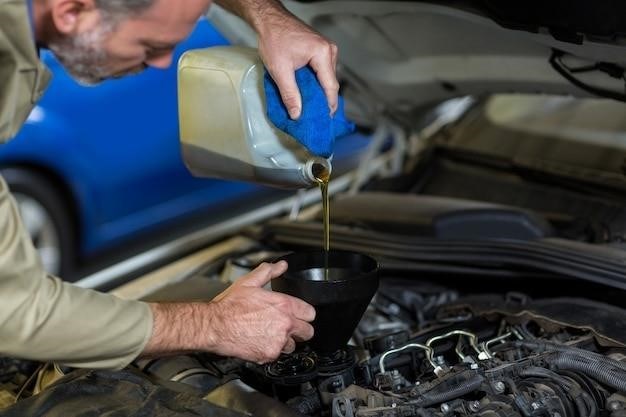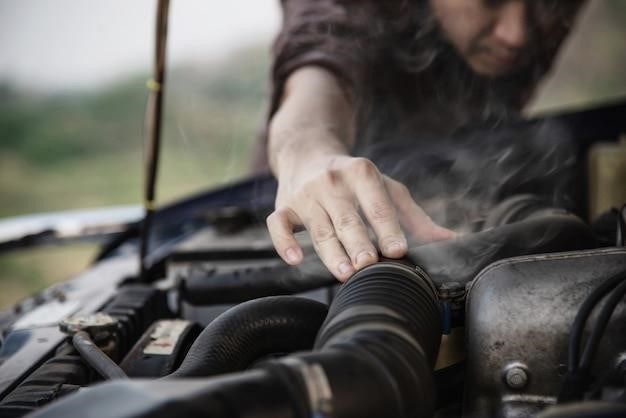
oil pressure engine off owners manual vw
Understanding the “Oil Pressure Engine Off” Warning
The “Oil Pressure Engine Off” warning in your VW indicates critically low oil pressure, threatening engine damage․ This necessitates immediate action to prevent catastrophic engine failure․ Ignoring this warning can lead to irreversible harm, requiring costly repairs or even engine replacement․ Understanding the cause is crucial for prompt and effective resolution․
Causes of Low Oil Pressure
Insufficient oil levels are a primary culprit․ Check your dipstick; low oil necessitates immediate refilling․ A faulty oil pressure sensor can trigger the warning light even with sufficient oil․ Inspect the sensor for damage or malfunction․ Worn-out engine components, including bearings, can compromise oil pressure․ These parts may require replacement to restore proper lubrication․ Oil leaks from seals, gaskets, or lines reduce oil pressure․ Thoroughly inspect all lines and connections for leaks․ A failing oil pump is another potential cause; it may need repair or replacement to restore adequate pressure․ Sludge buildup within the engine can obstruct oil flow, leading to insufficient pressure․ Regular oil changes using the correct grade are crucial for prevention․
Checking the Oil Level
Before attempting any repairs, verify the oil level․ Locate the oil dipstick, usually marked with a symbol resembling an oil can․ Remove the dipstick, wipe it clean with a lint-free cloth, and reinsert it fully․ Remove it again and check the oil level against the minimum and maximum markings on the dipstick․ If the oil level is below the minimum mark, add the correct type and amount of engine oil as specified in your VW owner’s manual․ Use a funnel to avoid spills․ After adding oil, wait a few minutes before checking the level again․ If the level remains low, investigate potential oil leaks․ Always consult your owner’s manual for the correct oil type and viscosity for your specific VW model and engine․ Adding too much oil can be just as detrimental as having too little․
Inspecting the Oil Pressure Sensor
The oil pressure sensor is a crucial component; a faulty sensor can trigger the “Oil Pressure Engine Off” warning even if oil pressure is sufficient․ Locate the sensor; its position varies depending on your VW model but is often near the oil filter․ Visually inspect the sensor for any obvious damage, such as cracks, leaks, or loose connections․ Carefully examine the wiring harness connected to the sensor for any signs of wear, fraying, or corrosion․ A damaged wiring harness can lead to inaccurate readings․ If you detect any physical damage to the sensor or wiring, it’s advisable to replace the sensor as a preventative measure․ However, a visual inspection alone may not pinpoint the problem; further testing might be required to confirm its functionality․ Remember to consult your VW owner’s manual for the specific location and inspection procedures for your vehicle․

Troubleshooting the Warning
Systematic troubleshooting is essential․ Begin by checking the oil level; low oil directly impacts pressure․ Then, inspect for leaks around the engine, paying close attention to seals and gaskets․ If these checks are inconclusive, proceed to more advanced diagnostic steps․
Testing the Oil Pressure
Accurately measuring oil pressure requires a specialized gauge․ This gauge is typically connected to the engine’s oil pressure sensor port or a test port specifically designed for this purpose․ Consult your VW owner’s manual to locate the correct port and understand the proper connection procedure․ With the engine running, observe the pressure reading at idle and various RPMs․ Compare your readings to the manufacturer’s specifications, usually found in the owner’s manual or a reputable online repair resource for your specific VW model and engine․ Low readings at idle or under load indicate a problem within the lubrication system․ Note that the pressure should increase with engine speed․ Failure to reach the minimum specified pressure confirms a low oil pressure condition, necessitating further investigation into the root cause․ This step provides quantitative data to guide your repair strategy, separating minor issues from more serious engine problems․
Identifying Potential Leaks
Visually inspect the engine for any signs of oil leaks․ Pay close attention to areas where oil lines and gaskets connect to the engine block, oil pan, and oil filter․ Look for wet spots, oil stains, or dripping oil․ Check the oil filter for leaks around its base and gasket․ Examine the oil pan gasket for any signs of seepage or leakage․ Carefully inspect all oil lines for cracks, damage, or loose connections․ Use a clean rag or paper towel to wipe suspected areas and then re-check for oil residue after a short period․ Don’t forget to check under the vehicle, as leaks might drip onto the ground․ A thorough visual inspection can quickly pinpoint the source of a leak, often a simple fix involving gasket replacement or tightening loose connections․ If you find a leak, carefully note its location to aid in repair․
Checking the Oil Pump
Assessing the oil pump requires more advanced mechanical knowledge and tools; A faulty oil pump is a serious issue, as it’s responsible for circulating oil throughout the engine․ First, verify oil level is correct․ Low oil can strain the pump․ Then, listen for unusual noises emanating from the pump area during engine operation․ A whining or knocking sound might indicate a problem․ To directly check the pump, the oil pan needs to be removed, providing access to the pump itself․ Inspect the pump’s drive gear for wear or damage․ Check for any obstructions within the pump that might impede oil flow․ A pressure test should be conducted to determine the pump’s output pressure․ This requires specialized equipment, often found in professional repair shops․ If the pressure is significantly below specifications or the pump shows damage, replacement is generally necessary․

Repairing Low Oil Pressure
Addressing low oil pressure requires identifying the root cause․ This may involve replacing the oil pressure sensor, repairing leaks in lines or gaskets, or tackling more serious internal engine problems․ Professional assistance is often needed for complex repairs․
Replacing the Oil Pressure Sensor
A faulty oil pressure sensor is a common cause of the “Oil Pressure Engine Off” warning․ Replacing it is a relatively straightforward procedure, often achievable with basic mechanical skills and tools․ However, consult your VW owner’s manual for precise location and removal instructions specific to your vehicle’s model and year․ Before starting, ensure the engine is cool and disconnect the battery’s negative terminal for safety․ Locate the sensor, usually near the oil filter, and carefully disconnect the electrical connector․ Unscrew the sensor using the appropriate wrench, taking care not to damage the threads․ Install the new sensor, ensuring a tight seal to prevent leaks․ Reconnect the electrical connector and the negative battery terminal․ Start the engine and check for any warning lights․ If the warning persists, further investigation is necessary․ Remember, incorrect installation could lead to inaccurate readings or further damage․ If you lack confidence in performing this repair yourself, seeking professional help is recommended․ Improper handling can lead to further complications․ Always follow manufacturer recommendations․
Repairing Leaky Lines or Gaskets
Oil leaks from lines or gaskets significantly reduce oil pressure, triggering the “Oil Pressure Engine Off” warning․ Identifying the leak’s source is crucial․ Carefully inspect all oil lines and gaskets for visible damage, paying close attention to areas near the oil filter, oil pan, and engine block․ Small leaks may require only tightening loosened connections or replacing damaged gaskets․ Larger leaks necessitate replacing entire lines or sections of the system․ This often involves draining the engine oil before disconnecting and removing the faulty component․ Always use manufacturer-specified replacement parts to ensure proper fit and sealing․ When replacing gaskets, ensure clean surfaces for optimal adhesion․ Apply a thin, even layer of appropriate sealant as recommended by the manufacturer․ After reassembly, carefully check for leaks by running the engine for a short time and visually inspecting all connection points․ If a leak persists, re-tighten connections or seek professional assistance․ Ignoring leaks can lead to severe engine damage and costly repairs, so address them promptly․
Addressing Internal Engine Issues
If external leak checks and component replacements fail to resolve the “Oil Pressure Engine Off” warning, internal engine problems may be the culprit․ Worn engine bearings are a common cause, allowing oil to escape and reducing pressure․ A failing oil pump, responsible for circulating oil, can also lead to insufficient pressure․ Sludge buildup within the engine, a result of infrequent oil changes or using unsuitable oil, restricts oil flow․ Diagnosing these internal issues often requires professional expertise․ A mechanic will likely perform a pressure test to accurately measure oil pressure at different engine speeds․ This helps pinpoint the source of the problem․ Repairing worn bearings or replacing the oil pump involves significant engine disassembly and is best left to qualified technicians․ Sludge removal might require a complete engine flush and oil system cleaning․ Neglecting internal engine issues can cause catastrophic engine failure, so prompt professional attention is vital for long-term engine health and reliability․ Early detection and intervention can save significant costs and prevent complete engine damage․